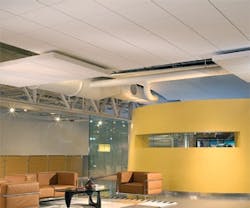Designers don’t need to look far to discover the origins of the exposed-structure aesthetic. In many cases, it begins with the design of their own offices.
Many design clients also like the exposed-structure aesthetic. It’s clean. It’s spacious. It’s inexpensive. It isn’t, however, acoustically friendly. One problem is speech intelligibility; the other is speech privacy.
Sound-absorptive ceiling panels can typically resolve both issues. Since exposed office structures generally don’t employ them, sound tends to rise up through pipes and plenums, reflecting off wood or metal decks, resulting in extended reverberation time (the time required for a sound to drop by 60 decibels).
The resulting echoes garble speech. As sound reflects off the deck, it may travel one, two, or three workstations away from its source, thereby compromising speech privacy.
Rules of Thumb for Acoustical Clouds and Canopies
Pinpoint the problem: “Fiberglass is the preferred material for speech privacy because it’s more absorptive than mineral board,” says Roy. “If your concern is echoing, either will do.”
Look at the whole picture: “Clouds, canopies, and the like are usually part of a more comprehensive effort to improve speech privacy or speech intelligibility with workstations and wall treatments,” says Ryerson. “The plan also may call for a sound-masking system.”
Lower is better: “Speech privacy is a function of the distance that sound travels,” Roy says. “The idea is to intercept it sooner rather than later.”
Observe the height rule: “If the space is 12 feet high, chances are you’re also going to require a wall treatment to reduce reverberation time,” says Roy. At 14 feet, you really don’t have much choice. One caveat: Windows may preclude placing absorptive materials on all four vertical surfaces. If that’s the case, locate the materials on adjacent rather than opposing walls. “That way, you achieve some absorption along both axes.”
Aesthetics be darned: Sometimes there’s no way around it. The deck or ceiling has architectural significance and therefore can’t, or shouldn’t, be obscured by a canopy or cloud. “You find that a lot with older buildings,” says Ryerson. “We usually suggest locating an acoustical treatment behind the ceiling or deck, and then introducing slots, so that the sound can reach the panels. It requires work and coordination with the architect and owner, but it’s not an impossible problem to resolve.”
This is a problem that Erik J. Ryerson, senior associate with Chicago-based acoustical consultant Shen Wilsom and Wilke, frequently encounters. “It’s of particular concern in environments where phones are continually in use, such as calling centers,” he says.
The simplest solution is a sound-absorptive acoustical cloud or canopy suspended from the deck or ceiling. The two leading candidate materials are fiberglass and mineral board, much as they are for fully suspended ceilings, Ryerson says. Due to its porosity, fiberglass tends to be the more efficient of the two alternatives. It also tends to be more expensive. “The problem,” says Ryerson, “is that, fair or not, there’s a perception that fiberglass isn’t environmentally friendly. As a result, we have clients that request mineral board, cotton, and the like.”
Before selecting a material, the owner or acoustical consultant should calculate the required noise reduction. Unlike fully suspended ceilings, whose performance is expressed as a noise reduction coefficient, the performance of clouds and canopies is expressed in sabins, which include the effects of both sides of the installation. A canopy that provides 20 sabins of absorption is twice as effective as one that provides 10.
All materials being equal, acoustical clouds and canopies tend to perform similarly, their differences more generally driven by aesthetic and manufacturing considerations. “Canopies tend to be more monolithic in nature, and are available in a variety of shapes, including convex, concave, square, circle, hexagon, and trapezoid, while clouds generally consist of several squares typically available in 2-foot by 2-foot increments,” says Ken Roy, senior principal research scientist with Lancaster, PA-based supplier Armstrong World Industries.
Chicago-based writer John Gregerson has more than 20 years of experience in the commercial buildings industry.
